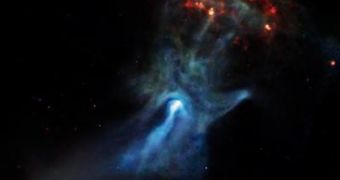Pulsars can be very unpredictable, and they can also generate cosmic phenomena that leave experts wondering whether what they learned of them is correct or no longer applicable. For instance, the PSR B1509-58 celestial body, designated B1509 for short, is a very small pulsar, barely 12 miles in diameter, which inhabits a portion of space roughly 17,000 light-years (160,820 trillion kilometers) away. In the middle of the formation is a fast-spinning neutron star.
This star is just the collapsed core of what was most likely a massive star, several times the weight of our Sun. Currently, it's shedding matter and energy at a very fast rate, and in the process generates numerous intricate shapes on the background around it, as seen from the Earth by NASA's Chandra X-ray Observatory. The formations, generated from matter and radiation, span more than 150 light-years all around the neutron star, and their shapes, sizes and compositions continuously change.
According to experts at The Smithsonian Astrophysical Observatory in Cambridge, Massachusetts, who control Chandra's science and flight, the neutron star revolves around itself more than seven times per second, and releases as much energy as it does presumably because the magnetic field of its surface is extremely powerful. Estimates say that the star may generate a field about 15 trillion times stronger than the Earth's magnetosphere.
Scientists believe that B1509's nebula bears some resemblance to that of the Crab Nebula, a more widely-known formation closer to our Solar System. However, despite being smaller, B1509 manages to generate a “remnant field” around it that is 15 times larger than that of its competitor.
In the recent pictures Chandra took, several filters and exposure times were taken of the region. Experts then realized that they were looking at one of the most powerful electromagnetic generators in the galaxy, able to create large and energetic winds of ions and electrons, and to spread them a huge distance away from the center of the nebula.

 14 DAY TRIAL //
14 DAY TRIAL //